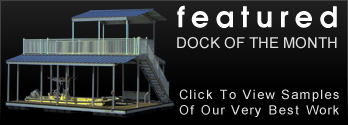Docks 101
Your primer course to the world of floating boat docks! Learn what makes a Wahoo Dock superior to any other brand and learn what sets Wahoo Docks apart in our field of competitors in four lessons that we dub Docks 101.

Mainframe
This is the frame, or backbone, of the dock. Wahoo Docks uses marine-grade aluminum for our dock mainframes.
Flotation
Floats are generally located underneath the mainframe structure. Wahoo Docks uses PermaFloat dock floats, which are extremely durable and offer a 15 year warranty. PermaFloat float drums meet Corps of Engineers regulations and are completely foam-filled for optimal buoyancy.
Bumpers
Bumpers protect both the dock and boats from damage as the motion of the water causes them to come into contact with each other. All our bumpers are made of black rubber or blow-molded polyethylene.
- P-bumper - This bumper is tacked onto the edge of the dock and provides surface protection against scratches and damage if the boat and dock come into contact with each other.
- Pole Bumpers - These bumpers attach to the dock poles and face outward so that boats and other watercraft will not make contact with the metal on the dock poles.
Decking
- Aluminum - Aluminum decking stays cool even on the hottest summer days. It is extremely durable and slip-resistant. Wahoo Docks created their very own line of aluminum decking called AridDek. AridDek is powder-coated in your choice of Sandstone, Granite, or Artisan Clay. It is water-tight, maintenance-free and will never require sealing, painting, or waterproofing.
- Ipe hardwood - Also called Brazilian Walnut, this wood is quickly becoming the most popular choice for wood decking. That is because it is one of the densest hardwoods available and can easily last for 25 years or more. Ipe is as fire-resistant as steel and is bug and mildew-resistant, which makes it the ideal wood choice for marine environments.
- Composites - When you want the look of wood without the expense or maintenance, composites can be the perfect solution. They are durable and low maintenance. Wahoo Docks offers TimberTech PVC decking materials for those interested in a high-quality composite decking.
- Concrete - Concrete is best used in commercial applications with heavy wave action.
Railing
- Hand Rails - Used for stability, especially along the gangway.
- Toe Rails - This rail is located on gangways rather than the dock itself. Handrails and toe rails can make a dock ADA-compliant.
- Wheel Rails - This rail prevents carts, coolers, and any wheeled objects from rolling off the dock.
Roof
- Hip Roof - This roof style generally has 4 sections that slope downward. It provides a compact, solid appearance and provides better wind resistance.
- Gable Roof - This style of roof has two sloping sides, with the ends sheer. An example would be an A-frame. On boat docks, the end pieces can be left off for an open-air design and greater clearance for taller boats.
Slips
Slips are the places where you park your watercraft. In most cases, there are two parallel fingers on either side of the boat, and the front of the boat moors into the main part of the dock.
Fingers
Fingers are the two parts of the dock that are perpendicular to the main dock and create two decks on either side of your boat when it is moored.
Mooring
- Cleats - Cleats are the fixtures, typically mounted on the edge of the deck surface of a dock, that boats can be tied to for mooring purposes.
- Mooring Poles - Mooring poles are fixed into the bed of the body of water with an auger and are typically attached to the dock.
And that's the end of Docks 101 but, if you're ready to start the advanced course and learn even more about the excellence of a Wahoo Dock, click on any of the links below.
Already sold? Ready to talk to a dealer? Use our simple Find a Dealer Map to get in touch with the authorized Wahoo Dealer nearest you, or you can contact us directly here.









